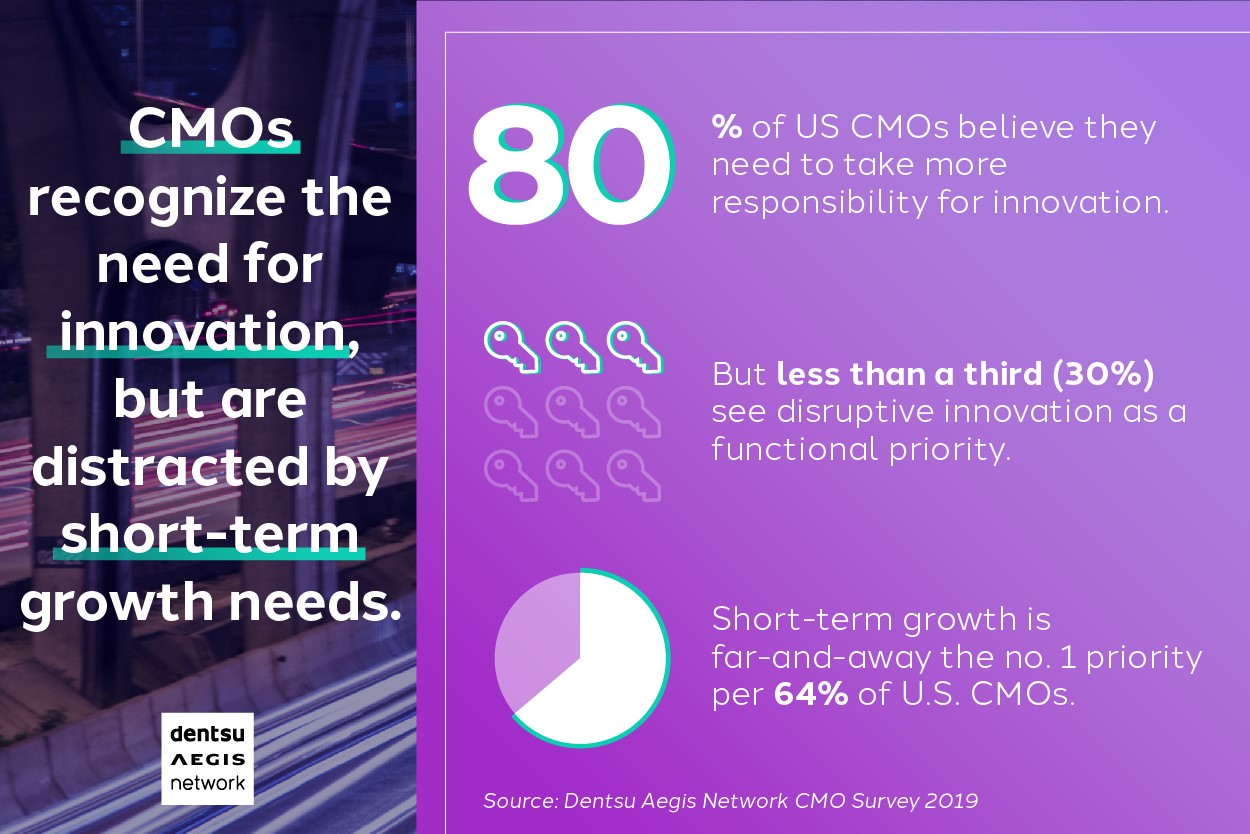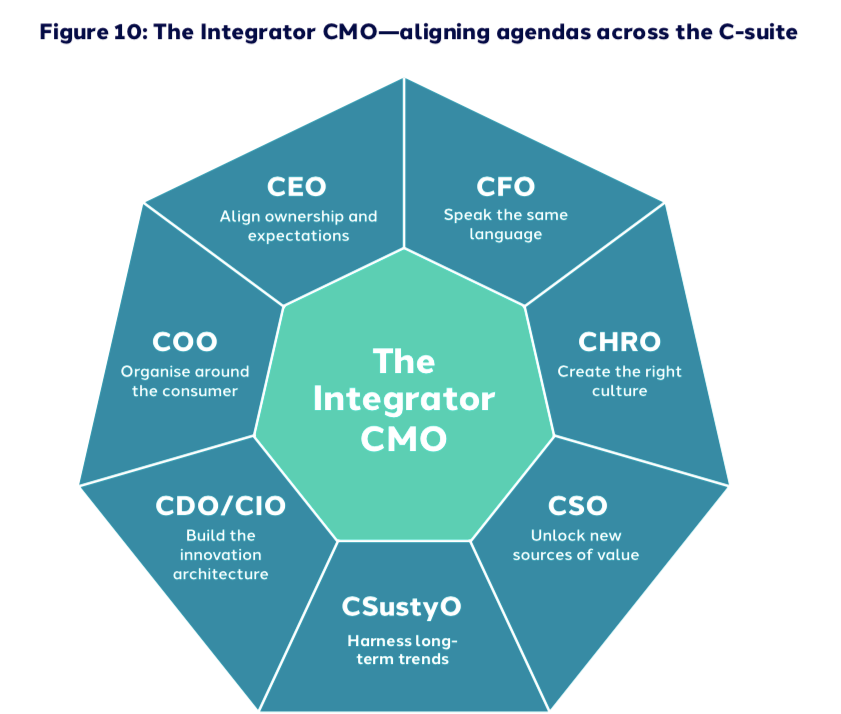The Ambidextrous CMO: Dentsu Aegis Network on Balancing Short-Term Goals with Audacious Transformation

It has never been a better time to be a chief marketing officer. The opportunity to drive both short-term business growth and long-term innovation through creativity, data, technology, customer experience and brand purpose underlies the most ambitious marketing agendas globally. Or does it? The Dentsu Aegis Network Global CMO Survey, released today, reminds us that the plight of the CMO is reminiscent of Dickens' sentiment, "It was the best of times, it was the worst of times." CMOs have better access to data, talent and resources than they have ever had and yet they are failing to navigate the tension between their short-term growth mandate and long-term sustained transformation.
The underlying reason for this is the expansive gulf between intention and actual behavior. The majority of CMOs (80 percent) recognize the imperative for business transformation but fail to execute on this intention, placing 'Business Transformation' and 'Disruptive Innovation' at the bottom of their functional priorities. Short-term growth remains the primary goal among 64 percent of U.S. CMOs and 61 percent globally.
To overcome this behavioral chasm, we need to arm CMOs with the skill of ambidexterity.
As Jim Collins, author of Built to Last, once eloquently shared: "A visionary company can do very well in the short term and very well in the long term." The CMO can serve as a role model of ambidextrous leadership by recognizing that any change effort requires close partnership with the chief executive officer (CEO) and the rest of the C-suite, as well as the ability to thrive in a VUCA (Volatile. Uncertain. Complex. Ambiguous.) world.
To do so, the CMO has to overcome numerous challenges. They include softening budgets for 41 percent of global CMOs — though 61 percent of U.S. CMOs expect increases; lack of integration across the customer experience value chain (for 49 percent of U.S. CMOs and 41 percent globally); insufficient control over digital investments and programs (38 percent U.S. and 36 percent globally); and competing C-suite agendas (30 percent U.S. versus 27 percent globally).
According to Dirk Herbert, chief strategy officer at Dentsu Aegis Network, U.S., helping CMOs overcome these challenges presents an opportunity for agencies to serve as strategic partners. "This is an opportunity for agencies to partner even more closely with marketers, as they work to fill the gaps and help create deeper engagement, connections and relevance among consumers now and into the future," he says.
To address these challenges, we have reframed the solutions recommended in the CMO Study into an alliterative5As framework.
5As: Key Drivers of CMO Success
Audacity
CMOs need to boldly address the dual challenge of delivering short-term results and the inability to secure long-term investment. Half of all CMOs rate this as a top-three concern. Nearly two-thirds of U.S. CMOs (64 percent) say they only plan 2.39 years ahead, on average.
This new audacious focus will require both an attitudinal and behavioral transformation based on culture — companies focused on culture are five times more likely to achieve breakthrough performance per Boston Consulting Group analysis — and it starts with the CEO. Emboldened by the CEO's support, the CMO can champion "longer-term measures of growth and overall brand health" according to the Global CMO Survey and firmly incorporate brand purpose into the DNA of the organization. Audacious creativity helped elevate KFC China to be seen as a "tech brand," resulting in 120 million loyalty members, for instance.
Agility
The ability to move swiftly while also being laser-focused on future innovation requires a leader that is comfortable with living in ambiguity, is highly persuasive and is extremely proficient at simplifying the complex. The CMO study provides tactics for achieving agility by using a more comprehensive approach to performance management, combining tangible and intangible metrics across time zones and adopting the versatility to toggle between agile innovation and more centralized strategies. Nespresso serves as a good example of an innovative entity that thrives separately from Nestlé, but also relies on centralized resources.
Authenticity
The race for purpose has galvanized brands to identify their raison d'etre in a way that enables short-term sales growth — and for many brands it has worked. However, the study indicates that these short-term gains can be short-lived if "purpose is not integral to the strategy, culture and operations of the business."
"The study shows that 74 percent of CMOs in high-growth companies believe social purpose will be critical to customer engagement, falling to 46 percent in high-decline companies. The CMO needs to elevate the purpose conversation beyond 'woke-washing," according to Unilever CEO Alan Jope. The first place to start is by combining standard marketing metrics with social impact metrics, but a full 75 percent of the brand campaigns studied fail to do so. Those who do will have a distinct advantage.
Alliances
The ambidexterity of the CMO needs to permeate across the entire C-suite through strategic relationship-building and alliances, starting first with the CEO. Pivoting an organization is a Herculean task that is too big for one person — no matter how skilled. According to the survey, today's CMO must step up as the "Integrator CMO" who, in partnership with the CEO, mobilizes the rest of C-suite including the chief financial officer, chief operating officer, chief data officer, chief technology officer, chief strategy officer, etc.
Accountability
CMOs often face accountability myopia where the short-term emphasis on customer growth blinds them to the strategic imperative of digital transformation. The CMO study shows that only 53 percent of CMOs at high-growth companies (revenue growth at 10 percent+) stay focused on long-term brand health. The CMO needs to be a judicious juggler evaluating metrics across time horizons, ROI payoffs and customer experience realities.
The CMO Legacy
Faced with the ironic distinction of being the shortest-tenured executive in the C-suite, the CMO is still charged with leading long-term and sustainable digital transformation across the organization, with 80 percent believing they need to take more responsibility for innovation over the next two to three years.
The CMO's dexterity in walking the tightrope of managing Wall Street's voracious appetite for short-term results with the critical mandate for disruptive innovation will require what F.Scott Fitzgerald would call a "first-rate intelligence." It is with that savvy that CMOs can balance and maximize the "potential for performance marketing and brand-building; short-term returns and long-term brand health; data excellence and creative flair," according to the CMO study.
Ultimately, the legacy of the CMO will not revolve around the latest quarterly customer growth rate, but will be reflected in the enduring DNA of the brand promise, the authenticity of the brand purpose and, most importantly, the emotional connection to the most critical stakeholder of all: customers.
Click the social buttons above or below to share this story with your friends and colleagues.
The opinions and points of view expressed in this content are exclusively the views of the author and/or subject(s) and do not necessarily represent the views of MediaVillage.com/MyersBizNet, Inc. management or associated writers.



